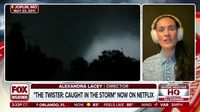Netflix's latest documentary, The Twister: Caught in the Storm, offers an unflinching look at the devastating EF5 tornado that struck Joplin, Missouri, on May 22, 2011. Released on March 19, 2025, this gut-wrenching film explores personal narratives and the destructive aftermath of one of the deadliest tornadoes in U.S. history.
The Joplin tornado, which remained on the ground for at least 32 minutes, claimed the lives of 158 people, making it the deadliest tornado in the U.S. in over 60 years. The documentary provides first-hand accounts from survivors, including those who found themselves caught in the eye of the storm. The footage is not only raw but profoundly impactful, featuring survivors recounting harrowing experiences as their lives were forever altered.
Director-writer Alexandra Lacey's documentary builds a deep, emotional connection with the audience by showcasing the stories of various individuals. Among those featured are a couple who sheltered in a freezer, a young school drop-out sucked from his car, and the captain of the high school’s football team who turned into a paramedic post-disaster. Lacey stated, "It was a difficult prospect to find the characters and make sure that we were treating each one of them the right way and making them feel comfortable to tell their story." Their testimonies bring to life the terrifying experience of that day and the complex emotions that linger over a decade later.
In addition to physical destruction, the aftermath of the tornado left lasting mental health impacts on the community. Lacey emphasized that “every time the wind gets stronger, or the sirens go… it’s really hard.” This insight lays bare the amplified psychological toll experienced by the residents of Joplin. As they learn to navigate life in the wake of such a catastrophe, many are left grappling with post-traumatic stress disorder (PTSD), anxiety, and the pervasive sense of loss.
Tragically, the disaster also led to 18 reported deaths by suicide post-tornado, a grim reflection of the tornado’s impact on mental well-being, as noted by Stephanie Brady of the Community Clinic of Southwest Missouri. The documentary dives into these realities, offering a stark contrast against the often sensationalized portrayals found in typical disaster films. Where fictional narratives might lean toward resolution and survival, The Twister: Caught in the Storm underscores the continual struggles faced by those who survived.
Adding further complications to the aftermath was the spread of a rare fungal illness known as mucormycosis. As the torn-up environment fostered breeding grounds for such diseases, the aggressive nature of mucormycosis led to five additional fatalities, heightening the disaster's toll. Through visceral storytelling, viewers witness the realities that linger long after the storm subsides.
Lacey approached this documentary with a unique vision, aiming to not just recount a natural disaster but also delve into human nature's resilience and the strength that emerges from adversity. With a background in television and documentary work, Lacey sought to create a feature that would resonate not only with history buffs but with anyone who can empathize with the shared experience of survival and recovery. "I think it just feels more important than ever that people understand the human impact of mother nature’s power," she expressed.
By focusing on a community’s journey instead of merely the disaster itself, Lacey hopes viewers come away with a sense of hope and an understanding of the importance of camaraderie. Her intention is to paint a picture of survival amid chaos while ensuring that the burdens carried by the residents of Joplin are equally acknowledged.
This documentary is also a coming-of-age story, shedding light on the lives of young individuals who were shaped by the experiences of that fateful day. The aim was for the film to transcend traditional disaster narratives and offer relatable perspectives for younger audiences. “I feel like [the kids] were forced to grow up in one day instead of over several years. But also, I think they each found their magic that day, their strength, their resilience,” Lacey noted.
In another layer of creative storytelling, Lacey and her team sifted through 6,000 visual clips of Joplin's tornado, combining archival footage with modern production techniques to create an immersive experience. By adopting slow-motion filming techniques to accentuate the memories of Joplin's citizens, the documentary achieves a delicate balance between horror and humanity, allowing viewers to feel the weight of the tragedy as well as the tenacity of the community.
Ultimately, The Twister: Caught in the Storm serves as a compelling reminder of the resilience inherent in the human spirit when faced with nature's destructive power. While it depicts harrowing events from a decade ago, its messages resonate universally: community, support, and hope endure.







